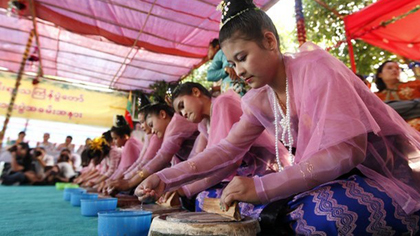Beauty That’s More Than Skin Deep

Burmese women feel great pride when they are asked to explain the golden paste covering their faces. This traditional skin conditioner has been used in Burmese society for centuries and is a cherished part of the national identity.
Fragrant thanaka is truly a Burmese household tradition. Every day, after taking a bath, women, children and even some men paint thanaka on their faces. Burmese people believe that thanaka bark cools their skin, tightens the pores and controls oiliness.
Women apply this cream in a variety of ways ranging from a casual smear to elaborate patterns, as a light coating or a thick mask. Especially those who work in paddy fields or toil outside for long periods of time will use thanaka as a protective shield on their exposed faces and arms, believing it protects their skin against the unforgiving tropical sunshine.
But wearing thanaka is also a centuries-old method of female Burmese beautification. Some women writers talk up thanaka as a traditional Burmese beauty secret. “Thanaka liquid has the properties of making the skin cool and smooth, having a refreshing and chilled fragrance, beautifying the users. It also cures pimples and acne,” notes researcher May May Aung in an online article.
Thanaka is made from the bark of a tree that has numerous uses. Thanaka wood is found in handicrafts such as combs, boxes and other small trinkets, and the tree’s roots are used as an “indigenous laxative,” according to May May Aung.
Traditionally, Burmese women grind the bark of the thanaka tree with a little water on a flat, circular stone called a kyauk pyin. This produces a milky yellow liquid that dries quickly when applied to the skin, forming a powdery protective covering.
The history of thanaka may date back to the earliest development of the country. Some believe that the legendary queen of Peikthano, an ancient Pyu city that flourished more than 2,000 years ago, was a lover of thanaka. According to historians, the Pyu people intermarried with Sino-Tibetan migrants who later became part of the Bamar (Burman) ethnicity.
The earliest written reference to thanaka in Burma is in a 14th century poem written by a consort of King Razadarit (or Rajadhirat), the monarch who successfully reunified all three Mon-speaking regions of southern Burma. He ruled from 1384 to 1422 and fended off major assaults by the Burmese-speaking northern Kingdom of Ava (Innwa). According to the authoritative book Myanma Thanaka, written by Thar Hla in 1974, the revered novice monk and poet Shin Maha Ratthasara, who lived from 1486 to 1529, also referred to thanaka in his work.
Further evidence of the antiquity of thanaka came following the destruction of the Shwemadaw Pagoda in Pegu, an ancient city located 76 km (47 miles) northeast of Rangoon, in the earthquake of 1930. Amongst the ruins was found a kyauk pyin used by Princess Razadatukalya. She was the eldest daughter of King Bayintnaung, who assembled the largest empire in the history of Southeast Asia and reigned from 1551 to 1581. The valuable antique stone was later donated to the pagoda.
Nowadays, thanks to modern scientific methods, thanaka is available as either a thick cream or a powder, making it easier to use. There are at least 200 brands in Nyaungbinlay Plaza, one of the biggest consumer markets in Rangoon. The best-selling brands are Shwepyinan, Shwebo Minthamee, Daw Thi, Taunggyi Maukmae, Natmimae, Phoe Wa, Papawaddy, Sanda and Sauntawku.
Traders who sell thanaka estimate that daily sales of the bark paste are worth many millions of kyat. They also say that many of the thanaka products sold in the market lack the official Ministry of Health stamp of approval.
Vendors claim that while user-friendly cosmetic products are more convenient, many Burmese women remain loyal to the traditional organic thanaka that has been used for generations because of concerns about the level of purity in the newer products.
“Organic thanaka is more expensive, but it really gives you a cooling sensation and protects your skin from arid weather. Ready-made versions are cheap but I’ve heard they are mixed up with soil, so I wouldn’t dare to use them,” said Aye Mya Kyi, a retailer at Nyaungbinlay Plaza.
The scientific name of the thanaka plant is Limonia acidissima. The tall, slow-growing tree is native to South and Southeast Asia and can grow on dry, rocky soil in areas without plentiful water. While other nations use its bark, leaves, root, fruits and gum for medicinal and other purposes, only the Burmese wear thanaka as a daily cosmetic and skin conditioner. Burmese people believe that the best thanaka plants are naturally slow-growing, taking three to 10 years for the trunk to reach two inches in diameter.
1 | 2 next page »
|
||
|
||
|
||
|
||
|
||
|
||
|
||
|
||
- Students Without a University
- Displaced and Distressed
- Training the Next Generation of Kachin Rebels
- Rangoon Art Show Provides Arresting Display
- Magical Mandalay Still Holds Court for Tourists
- Distrust and Displacement on Kachin Frontline
- Thein Sein: Reformist or Caretaker?
- School’s Not Out in Kachin State
- Irrawaddy Dolphins are Firm Fisherman’s Friends
- Thein Sein: Reformist or Caretaker?
